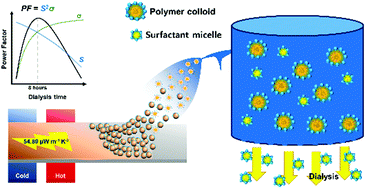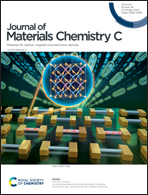Thermoelectric power factor exceeding 50 μW m−1 K−2 from water-borne colloids of polymer semiconductors†
Abstract
An environmentally benign process for the fabrication of polymer thermoelectrics is proposed based on a miniemulsion synthesis for transferring polymer semiconductors dissolved in organic solvents to aqueous media with surfactants. Considering that the particle size of the colloid and concentration of the surfactant micelles can affect the final morphology of films cast from the colloidal solution, the dialysis time for extraction of the surfactant from the colloidal solution was systematically varied to achieve poly(2,5-bis(3-tetradecylthiophen-2-yl)thieno[3,2-b]thiophene) (PBTTT-C14) colloidal films with diverse morphologies. Morphological and structural analyses indicated that a longer dialysis time produced a larger particle size owing to Ostwald ripening, in addition to a lower interparticle depletion force as a result of the reduced amount of surfactant micelles. These competing phenomena in the colloidal solutions prior to solidification yielded smoother and more continuous film morphologies as the dialysis time increased. Interestingly, although the charge carrier mobility and electrical conductivity gradually increased with the dialysis time as the film morphology became smoother, however, the Seebeck coefficient tended to increase as the crystalline disorder increased presumably because of the broadened density of states. The resulting organic thermoelectrics with the optimized film morphology rendered a high Seebeck coefficient of 495.96 μV K−1 and power factor of up to 54.89 μW m−1 K−2. This approach opens the possibility of fabricating high-performance organic thermoelectrics with water as a processing solvent.



 Please wait while we load your content...
Please wait while we load your content...